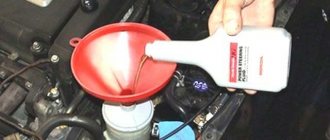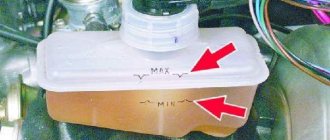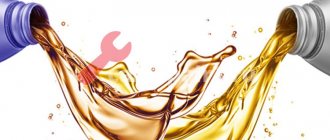What kind of oil should I put in the power steering? This question interests car owners in different cases (when changing fluid, when buying a car, before the cold season, and so on). Japanese manufacturers allow automatic transmission fluid (ATF) to be filled into the power steering system. But European ones indicate that it is necessary to pour special fluids (PSF). Externally they differ in color. Based on these main and additional features, which we will consider below, it is precisely possible to determine what kind of oil to put in the power steering.
What is power steering fluid
Power steering fluid is a specialized fluid that acts as a working fluid in the hydraulic power steering systems of cars, tractors and other wheeled vehicles.
Modern cars and trucks, buses, tractors and other wheeled vehicles are equipped with a system that facilitates the driver’s work - hydraulic power steering (power steering). This system consists of a liquid pump driven by the engine crankshaft, a power actuator, a control mechanism and piping. The actuator is racks or steering mechanisms with bipods, and the control mechanism is a distributor integrated with the rack or steering mechanism, which controls fluid flows depending on the direction and angle of rotation of the steering wheel.
Power steering uses various fluids as a working fluid, which are assigned several important functions:
- Transfer of force from the power steering pump to the actuator, which ensures the rotation of the steered wheels;
- Lubrication of rubbing parts of the power steering system;
- Protection of metal elements of power steering from corrosion;
- Cooling of the rubbing parts of the power steering system.
All these functions can be most effectively performed only by special fluids designed for use in power steering. These liquids have a number of features and distinctive features, which should be discussed in more detail.
Classification of power steering hydraulic fluids
Fluids used in power steering can be divided according to several criteria:
- Color;
- Compound;
- Variety.
Color classification
It is wrong to be guided only by color gradation when choosing oil, although this practice is widespread among car owners. It is also often indicated what color liquids can be mixed and which ones should not be mixed.
Mixing is contraindicated with liquids based on composition and not color, and since now both mineral water and synthetics can be presented in any color, you should treat this information very carefully.
Red ATF gear oil is usually synthetic, the Dexron brand from General Motors is considered the standard, but there are products from other manufacturers, such as Revenol, Motul, Shell, Zic, etc.
Yellow oil, produced by the Daimler concern and under its license, is used in Mercedes-Benz hydraulic boosters. It can be synthetic and mineral.
Green oil. For the most part, multifunctional and universal liquids can be either synthetic or mineral in composition. They are used in power steering, suspension and other systems that operate on liquids. It cannot be mixed with other colors, except in cases where the manufacturer declares full compatibility, for example Comma PSF MVCHF is compatible with some types of Dexron.
Reds
They belong to the ATF class, that is, transmission. Most often used for automatic transmissions, but sometimes also used for power steering. The red brands Dexron II and Dexron III are developed by the automobile concern General Motors. There are other red brands, but they are manufactured under license from General Motors.
Yellow
This liquid is considered universal. This type of oil can be found in most hydraulic power steering systems. This lubricant is also used in manual and automatic transmissions.
Green
Synthetic or mineral based oil. For use exclusively in manual transmissions. You can use such a lubricant in power steering, but before doing this you need to drain all the old fluid and flush the system.
Types of power steering fluids
Power steering fluids must have different properties, which are provided by additives and chemical composition. Among them:
- required viscosity index;
- temperature resistance;
- mechanical and hydraulic properties;
- corrosion protection;
- anti-foam properties;
- lubricating properties.
All power steering fluids on the market have all these characteristics to one degree or another.
In turn, according to their chemical composition they are distinguished:
- synthetic;
- semi-synthetic;
- mineral oils.
Let's look at their differences and scope of application.
Synthetic
Synthetics are based on hydrocarbons (alkylbenzenes, polyalphaolefins) and various esters. All these compounds are obtained as a result of directed chemical synthesis from oil. This is a base to which various additives are added. Synthetic oils have the following advantages:
- high viscosity index;
- thermal-oxidative stability;
- long service life;
- low volatility;
- resistance to low and high temperatures;
- Excellent anti-corrosion, anti-foam and lubricating properties.
But even with such characteristics, fully synthetic oils are rarely used in power steering systems due to the many rubber seals that are aggressively affected by synthetics. Synthetics are used only if approved by the manufacturer. Another disadvantage of synthetics is the high price.
Semi-synthetic
To neutralize the aggressive effect on rubber parts, manufacturers add a variety of silicone additives.
Mineral
Mineral oils are based on various petroleum fractions, such as naphthenes and paraffins. 97% is a mineral base, the other 3% is additives. Such oils are more suitable for power steering, as they are neutral to rubber elements. Operating temperature ranges from -40°C to 90°C. Synthetics work up to 130°C-150°C, the lower limit is similar. Mineral oils are affordable, but in other respects they are inferior to synthetic ones. This concerns service life, foaming and lubricity.
What kind of oil should be poured into the power steering - synthetic or mineral? First of all, the one recommended by the manufacturer.
Differences between hydraulic fluids
Dexron. Lubricants have been produced since 1968. This is a separate class created by General Motors Corporation. Dexron is an official brand and is not manufactured exclusively by GM.
ATF (Automatic Transmission Fluid) - lubricants intended for automatic transmissions. Widespread among Japanese manufacturers. Often such hydraulic oil is found in power steering, most of it has a red tint.
PSF (Power Steering Fluid) – oil for hydraulic booster.
Multi HF are universal hydraulic oils for use in hydraulic power steering systems, allow complete mixing and interchangeability, and have approvals from many automakers. This oil is the best choice when purchasing.
Is it possible to mix different colors
It’s worth saying right away that it’s generally better not to allow different oils to mix, even if this is allowed. It is strictly forbidden to mix synthetic and mineral oils due to their differences in chemical composition.
Yellow and red colors can be mixed, since their chemical composition is largely similar. Additives will not react with other substances. But it is better to then change this mixture to a homogeneous one.
Green oils cannot be mixed with others, as they have a universal chemical structure, that is, synthetic and mineral components.
It is necessary to mix oils during topping up, when the liquid level in the tank drops. This indicates a leak that needs to be identified and repaired.
Changing power steering oil - description of the process
Replacing the lubricant in the power steering is a rather painstaking task; you should take the procedure seriously and follow the instructions.
Adding fluid
To add oil, it is recommended to purchase Multi HF universal fluid, since it can be mixed with absolutely any lubricant.
Instructions for adding hydraulic lubricant to the power steering:
- Inspect the power steering reservoir and mechanism for leaks. If there are any, they need to be eliminated;
- Check the hydraulic oil level in the power steering reservoir;
- After removing the plug, add fluid to about;
- Start the engine and turn the steering wheel from the extreme left to the extreme right;
- Check the lubricant level in the power steering reservoir and, if necessary, top up to about.
Complete fluid change
A complete lubricant change requires great perseverance and coordination. Hydraulic oil must be selected based on the manufacturer’s recommendations.
- Hang up the car. This is done to facilitate rotation of the steering wheel when the engine is off;
- We will need a syringe - we need to pump out all the fluid from the power steering reservoir;
- Then loosen the clamps on the hoses, remove them from the tank, rinse the container itself thoroughly;
- Direct the return line (steering rack hose) into an empty jar - the liquid remaining in the rack will drain there;
- By turning the steering wheel, remove any remaining lubricant from the mechanism. It is required to make quite intense and prolonged movements with the steering wheel;
- After the hydraulic oil stops leaking, you need to fill (rinse) the rack with freshly purchased fluid. To do this, insert a funnel into the second hose and fill it to capacity;
- After this, we repeat the manipulations with the steering wheel again. When all the oil has flowed out of the return hose, the procedure can be completed;
- Then reassemble the hydraulic power steering system in reverse order;
- Fill the mechanism reservoir with oil according to the level;
- After the system is filled, you need to turn the steering wheel from the extreme left position to the extreme right. Such manipulations should be carried out with the engine running;
- We turn off the engine, lower the car, check the tightness of the connections, and add fluid to the amplifier tank to the maximum.
This is interesting: How to paint a car bumper with your own hands?
Belt Drive Power Steering Pump
Signs of a Leak
Signs that may indicate a power steering fluid leak or indicate the need to replace it:
- level drop in the tank;
- smudges have appeared on the seals or seals of the system;
- There is a knocking sound in the steering rack when driving;
- the steering wheel turns tightly, with effort;
- The power steering pump makes strange noises, a hum.
To fill the power steering fluid, you must first of all use the manufacturer's recommendations. Try to use one brand and avoid mixing. If you have to mix different oils, remember that mineral and synthetic oils are incompatible, even if they are the same color. It is also necessary to regularly monitor the oil level and its condition.
Terms of use of liquids
It is also worth taking care of how to change the oil in the hydraulic booster. Such information is always contained in the car’s service book. No less often, manufacturers recommend not changing this oil at all. They are guided by a simple rule: the service life of the mixture is designed for the average life of the machine.
But a car can serve faithfully for quite a long time. If the fluid is not original, it needs to be changed more often. Some manufacturers clearly prescribe the procedure for replacing the fluid, including taking into account cases when the composition is not original. Often the control period ranges from 50 to 100 thousand kilometers.
If there is a problem with the power steering system, the first thing you need to do is change the oil. It is also worth checking the condition of the fluid in the power steering. If it has darkened, thickened, or smells unpleasant, it needs to be changed. By the way, synthetic compounds can be used much longer.
Is it possible to fill the power steering with engine oil?
Motor - definitely not, transmission - with reservations. Next we will look in detail why.
To understand whether other oils, such as motor or transmission oils, can be poured into the power steering, you need to know what functions it performs.
The power steering fluid must cope with the following tasks:
- Lubrication of all power steering components;
- Protection against corrosion and wear of parts;
- Pressure transfer;
- Prevents foaming;
- System cooling.
The above characteristics are achieved by adding various additives, the presence and combination of which gives power steering oil the necessary qualities.
As you understand, the tasks of motor oil are somewhat different, so it is highly not recommended to pour it into the power steering.
Regarding transmission oil, everything is not so clear; the Japanese often use the same ATF fluid for automatic transmission and power steering. Europeans insist on using special PSF (Power Steering Fluid) oils.
Is vape juice completely safe for health?
For those who care about the health of their body, it is necessary to select high-quality liquid. Or, if you mix it yourself, buy expensive components.
You can find the proportions in which to mix the components on the Internet. However, if the vaper purchased low-quality products, then the e-liquid will not be safe. It is recommended to carefully study the inscriptions on the label.
Harm to the body begins when some vapers start vaping an electronic cigarette without stopping. They do not feel full of nicotine, and therefore do not let go of the vape around the clock.
Even though vaping liquids use purified nicotine, it is still harmful to health. It negatively affects:
- Airways;
- Stomach;
- Liver;
- CNS;
- Cardiovascular system.
The process of purifying medical alcohol is an extremely expensive process. For this reason, cheap e-liquids are unlikely to contain high-quality nicotine.
Also, some other components of the liquid can harm human health. For example, glycerin, if constantly steamed, causes dry skin. The result is thin and flaky skin on the face and hands.
A safe smoking method has not yet been invented.











